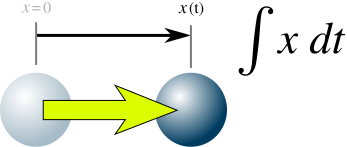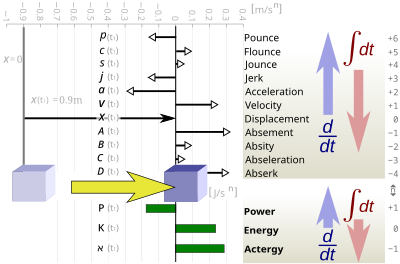Absition
This article provides insufficient context for those unfamiliar with the subject. (January 2016) (Learn how and when to remove this template message) |
| Absition (Absement) | |
|---|---|
 When a particle moves, its motion can be described by the integrals of displacement, including absition (absement), absity, abseleration, etc., as well as the derivatives of displacement, including velocity, acceleration, jerk, jounce, etc. | |
Common symbols | A |
| SI unit | m·s, m s |
| Part of a series on |
| Classical mechanics |
|---|
|
Core topics |
|
Categories |

Absition is a measure of sustained absence from a particular spatial position, i.e. a measure of how far away and for how long. Absition increases as an object remains absent for longer periods of time. The word "Absition" is a portmanteau of the words "Absence" and "Position", and is also known as Absement (portmanteau of "Absence" and "Displacement")[1] ,.[2] Mathematically, it is the first integral of displacement.,[3][4] i.e. it is defined as the time-integral of displacement. It is measured in units of displacement times time. The rate of change of absition is position. Absition (absement) is measured in meter·seconds (m·s).
In 2013, Maya Burhanpurkar won the Grand Platinum award of the Canada-Wide Science Fair for showing experimentally, that the amount of water flowing through a gate valve is linearly proportional to the absement of the gate (squared correlation coefficient better than .99).[5][6][7][8]
An absement of 1 m·s corresponds to an object that has been absent from an origin 1 meter away for 1 second, .5 meters away for 2 seconds, 4 meters away for .25 seconds, etc. For example, when the gate of a gate valve (of rectangular cross section) is open 1mm for 10 seconds, the same amount of water flows through it, as when it is open 10mm for 1 second, or 2mm for 5 seconds, etc., and, more generally, the amount of water going through it is linearly proportional to the area under the time-distance curve of how open the valve is; this is useful for modeling the throttle of an engine, e.g. for jet fuel in avionics (the amount of fuel is proportional to absement, which is proportional to total energy transfer in the fuel).[9]
Absement is also part of the subject matter taught in schools, and formed the basis for material deployed to more than 900 schools, originally developed at the Harbourfront Centre.[10][11]
Occurrence in nature[edit]
Absement occurs where there is a flow, and its accumulation (effecting an integration of distance or displacement), such as in water flow through valves, in water flow into reservoirs,[12][13][14] or in charge on capacitors and related electric circuits.
Flow-based musical instruments, such as the hydraulophone, exhibit this phenomenon inherently: whereas a piano produces note strength in proportion to the velocity at which the keys are struck, and the organ (a true tracker organ) produces note strength in proportion to how far down a key is pressed (displacement), the hydraulophone produces note strength in proportion to the time-integral of the distance down the water "key" is pressed. Thus pressing on the key (water jet) for a longer period of time will result in a buildup in sound level, as water begin to fill up the sounding mechanism (reservoir).up to a certain maximum filling point beyond which the sound level is off(along with a slow decay).
Dimitri Jeltsema's seminal 2012 work showed that absement has an analog in electric circuits, resulting in a fundamental new way of modeling electric circuits.
Useful applications of Absement[edit]
In addition to modeling fluid flow and for lagrangian modeling of electric circuits (Jeltsema 2012), absement is used in physical fitness and kinesiology to model muscle bandwidth, and as a new form of physical fitness training.[15][16] In this context, it gives rise to a new quantity called Actergy, which is to Energy, as Energy is to Power. Actergy has the same units as Action (Joule Seconds) but is the time-integral of total energy (time-integral of the Hamiltonian rather than time-integral of the Lagrangian).
Fluid flow in a throttle:
"A vehicle's distance travelled results from its throttle's absement. The further the throttle has been opened, and the longer it's been open, the more the vehicle's travelled." [17]
Relation to PID controllers[edit]
PID controllers are controllers that work on a signal that is proportional to a physical quantity (e.g. displacement, proportional to postion) and its integral(s) and derivative(s), thusly defining PID in the context of Integrals and Derivatives of a position of a control element in the Bratland sense[18]
Quoting Bratland etal.:
"depending on the type of sensor inputs, PID controllers can contain gains proportional to position, velocity, acceleration or the time integral of position (absement)..."
Example of PID controller (Bratland 2014):
P = Position; I = Absement; D = Velocity.
Higher integrals[edit]
Just as displacement and its derivatives form kinematics, also displacement and its integrals form "Integral Kinematics" (Janzen etal 2014), giving rise to the ordered list of nth derivatives of displacement:
+4 Jounce +3 Jerk +2 Acceleration +1 Velocity =0 Displacement -1 Absement -2 Absity -3 Abseleration -4 Abserk
Absement and Absementom[edit]
Recent work in mechanics and memristors and memcapacitors further builds on the concept of absement, and assigns it the letter "a",[19] and makes extensive use of plots such as the graph of absement as a function of displacement:
...amplitude of the sinusoidal displacement with period T = 2π/ω, and a0 = A/ω is the value about which the analytic absement a(t) oscillates. [Pei etal 2015].
See Table 4, "Analytic Displacement and Absement" versus "Piecewise Continuous Displacement and Absement".
Strain absement[edit]
Strain absement is the time-integral of strain, and is used extensively in mechanical systems [Pei etal 2015] and memsprings:
quantity called absement which allows mem-spring models to display hysteretic response in great abundance.
See also[edit]
References[edit]
- ↑ "Absement, displacement, and velocity-sensitive music keyboard in which each key is a water jet", by Mann, Janzen, and Post, In Proceedings of the 14th annual ACM international conference on Multimedia, pp. 519-528. ACM, 2006.
- ↑ Derivatives of position by Amarashiki, 2012/11/10
- ↑ Jin-Song Pei, Joseph P. Wright, Michael D. Todd, Sami F. Masri, François Gay-Balmaz (2015). Understanding memristors and memcapacitors in engineering mechanics applications. Springer. Abstract: "for example, a new concept and state variable called “absement,” the time integral of deformation, emerge."
- ↑ Dimitri Jeltsema (2012). Memory Elements: A Paradigm Shift in Lagrangian Modeling of Electrical Circuits. arXiv:1201.1032. Abstract: "Although time-integrated charge is a somewhat unusual quantity in circuit theory, it may be considered as the electrical analogue of a mechanical quantity called absement."
- ↑ Burhanpurkar 2013 http://www.developinginnovations.org/?page_id=1142
- ↑ Oro-Medonte teen wins Canada-Wide science award, lunch with an astronaut By Gisele Winton Sarvis, Postmedia Network, Monday, May 26, 2014 8:36:29 EDT PM 2014
- ↑ Maya Burhanpurkar Student Scientist Entrepreneur http://mayab.ca
- ↑ Best of Physical and Mathematical Sciences Best of Category (PM 301) Absement: Direct Evidence of the Time-Integral of Distance Student: Maya Burhanpurkar School: Barrie North Collegiate
- ↑ Online Edition; Local Student Wins National Science Fair; Category: June/July 2014; Published on May 30, 2014; http://www.northsimcoenews.com/index.php/online-edition/78-june-july-2014/1530-local-student-wins-national-science-fair
- ↑ "Hydraulophone Absement Theory", Harbourfront Centre, Toronto, Ontario, Canada, March 13, 2008
- ↑ "The Water Labs at the nexus of science, innovation, arts, culture, sustainability, health, wellness, mathematics, music, fun, and frolic", Hydraulikos Urban Water Innovation Laboratory missions statement, 2011 November 22
- ↑ Dietz, Paul H., Gabriel Reyes, and David Kim. "The PumpSpark fountain development kit." In Proceedings of the 2014 conference on Designing interactive systems, pp. 259-266. ACM, 2014.
- ↑ Burhanpurkar inspired by Newton's theories, By Roberta Bell, Orillia Packet & Times, Tuesday, March 26, 2013 9:08:02 EDT PM
- ↑ Ontario girl, 14, wins spot at international science fair for validating one of Isaac Newton’s key laws of physics ROBERTA BELL, QMI Agency, NEWS CANADA, lfpress, Wednesday, March 27, 2013 1:33:10 EDT PM
- ↑ "Actergy as a Reflex Performance Metric: Integral-Kinematics Applications", Janzen etal., in Proceedings of the IEEE GEM 2014, pp. 311-2. DOI: 10.1109/GEM.2014.7048123
- ↑ "Integral Kinematics (Time-Integrals of Distance, Energy, etc.) and Integral Kinesiology", by Mann etal, in Proceedings of the IEEE GEM 2014, pp. 270-2.
- ↑ "What does the area under a distance-time graph correspond to?" Quara, 23 Jun 2014
- ↑ Bratland, Magne, Bjørn Haugen, and Terje Rølvåg. "Modal analysis of active flexible multibody systems containing PID controllers with non-collocated sensors and actuators." Finite Elements in Analysis and Design 91 (2014): 16-29.
- ↑ Pei, Jin-Song, Joseph P. Wright, Michael D. Todd, Sami F. Masri, and François Gay-Balmaz. "Understanding memristors and memcapacitors in engineering mechanics applications." Nonlinear Dynamics 80, no. 1-2 (2015): 457-489.
This article "Absition" is from Wikipedia. The list of its authors can be seen in its historical. Articles copied from Draft Namespace on Wikipedia could be seen on the Draft Namespace of Wikipedia and not main one.

